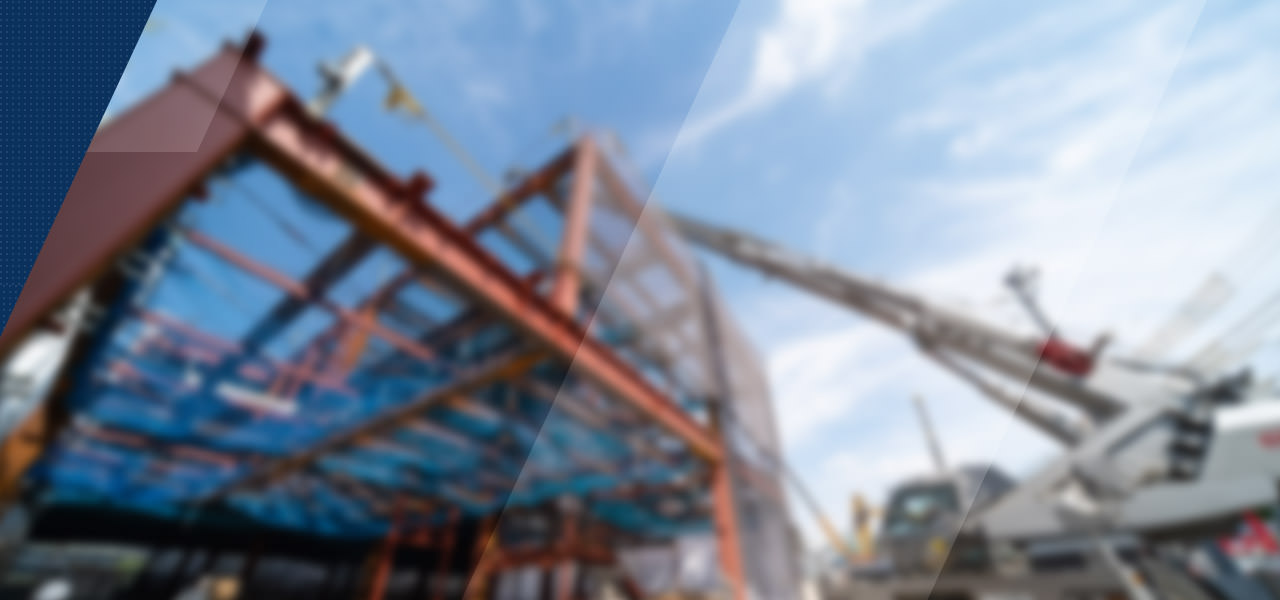
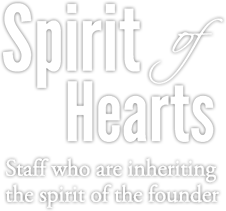
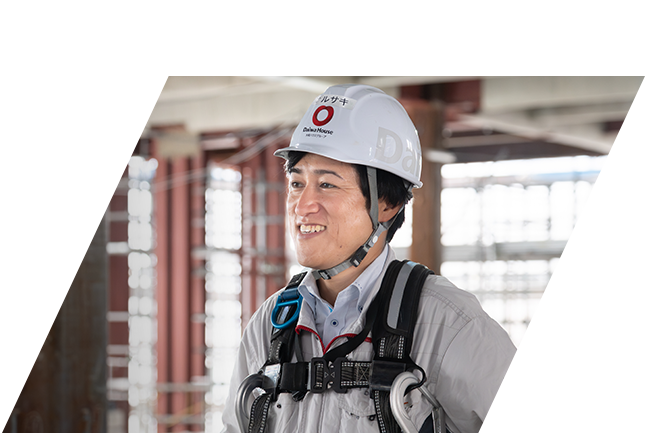
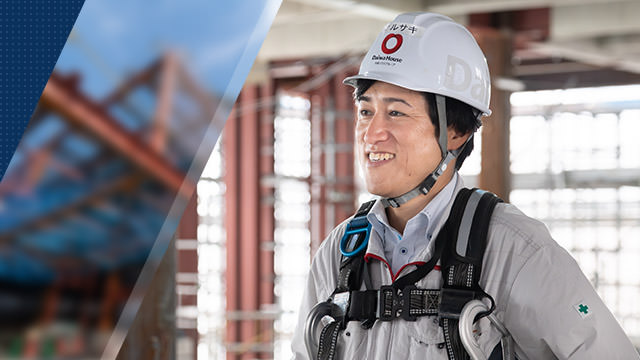 “Transforming the
“Transforming the
Construction Sector with DX”
Daiwa House Industry DX has entered a new phase. Introducing DX to construction sites will transform the way employees work while also bringing innovation to Japan’s construction industry.
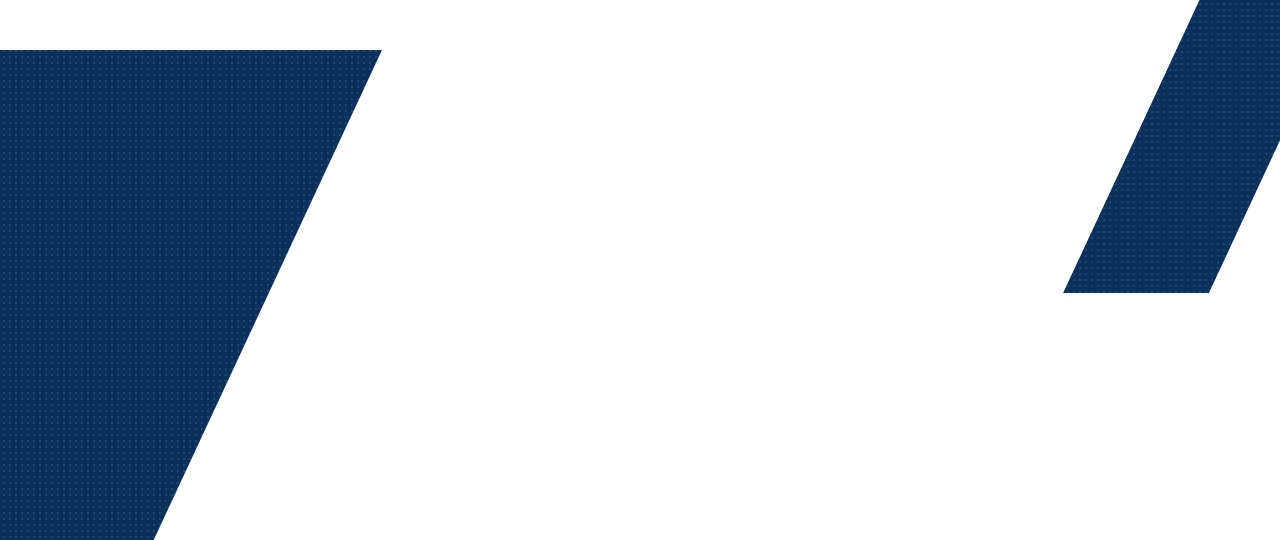


![]()
![]()
![]()

![]()
![]()
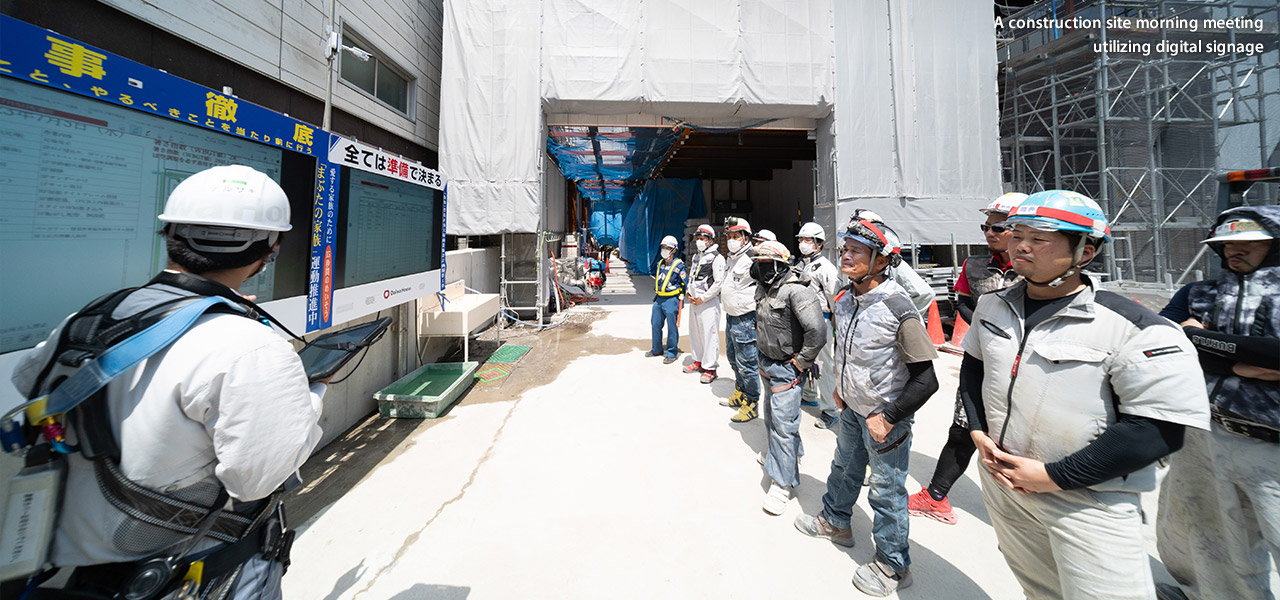
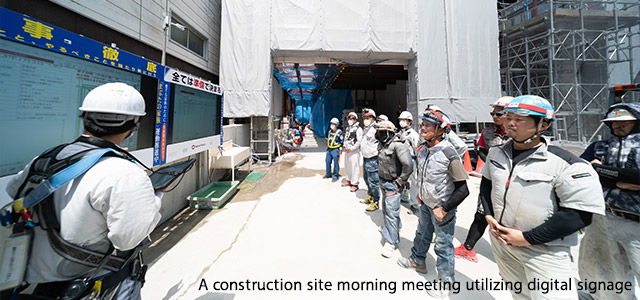

DX, a solution for the
construction industry
As new cityscapes appear with increasing regularity, construction site supervisor Kazuma Terusaki finds that every day he has a lot on his plate. For the past several years he has overseen hotel construction, mainly in the Kanto region, and currently, he is actively engaged at a commercial facility site near the JR Yamanote Line.
During on-site morning meetings, digital signage is used to share work details and precautions. Up until now, information was conveyed by using hard copy paper or verbal instructions, but having switched to digital, analog is a thing of the past. Daiwa House Industry is forging ahead at breathtaking speed to introduce such digital signage as part of its “construction DX” (digital transformation).
Today, the construction industry, and construction sites in particular, are confronted by enormous challenges. These include labor shortages, regulations that will limit overtime work, otherwise known as the “2024 problem,” and lingering analog workflows within a society that is increasingly digitalized and working remotely.
Construction sites are underpinned by contractors who employ highly experienced laborers, many of whom are in their 50s and 60s. When such skilled workers retire, the sites that had made it through thanks to the abilities of these master craftsmen are very likely to stagnate. Fortunately, Daiwa House Industry has been able to secure manpower with the help of its partner companies, but there are strong indications that this will not always be the case. Last summer, they were unable to arrange for a formwork carpenter and finally had to have one come from Okinawa.
Daiwa House Industry is not alone in facing the problem of regulations that will limit overtime work—across the construction industry companies are agonizing about how to cope. One of the underlying factors is the incredibly large number of work tasks in construction operations. When Terusaki counted the number of drawings and other data he had created at a particular site, he found that it came to roughly 400,000. On top of that, he says, “It’s as difficult to get an accurate hold on the volume of work in architectural construction management as it is to grasp the volume of a cloud.” Many of the buildings they work on are custom-made, unlike manufacturing or systems architecture, so design changes often occur after construction has begun. This is partly due, he believes, to the necessity to respond to ever-changing circumstances, making it difficult to determine time allocation and the amount of work that needs to get done.
In 2019, Terusaki joined the BIM* Promotion Project to spearhead the DX initiative, and was later to be appointed as the main DX driver for architecture. BIM has been promoted since 2017 in our design efforts, but it has now also begun to play a role within our operations in the construction area.
“In the first place, what is DX at a construction site? And where do we even start?”
We called in several DX leaders and gathered members of the Digital transformation Department, but none of them had the right answers. First off, one thing revealed itself from among the digital tools used and other efforts made with tasks performed on site, and all the repeated trials that we made.
While we had thought that BIM equals 3D CAD, after activities had been going on for about one year, Terusaki began to realize that this was also about accumulating digital data with BIM, and putting that data to use for a revolutionary workflow that streamlines operations. His feelings were that “BIM is a huge, central lynchpin that will further improve business efficiency by linking BIM-related applications and IoT instruments, as well as ICT construction equipment.”
*Building Information Modeling (BIM), a revolutionary workflow, adds a variety of attribute data to 3D digital models for buildings, utilizing that information at every step of the process.
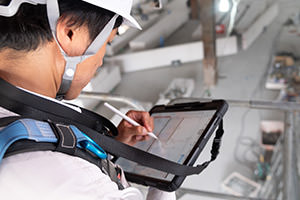
Using tablets to manage on-site progress and procedures

Information sharing through digital signage
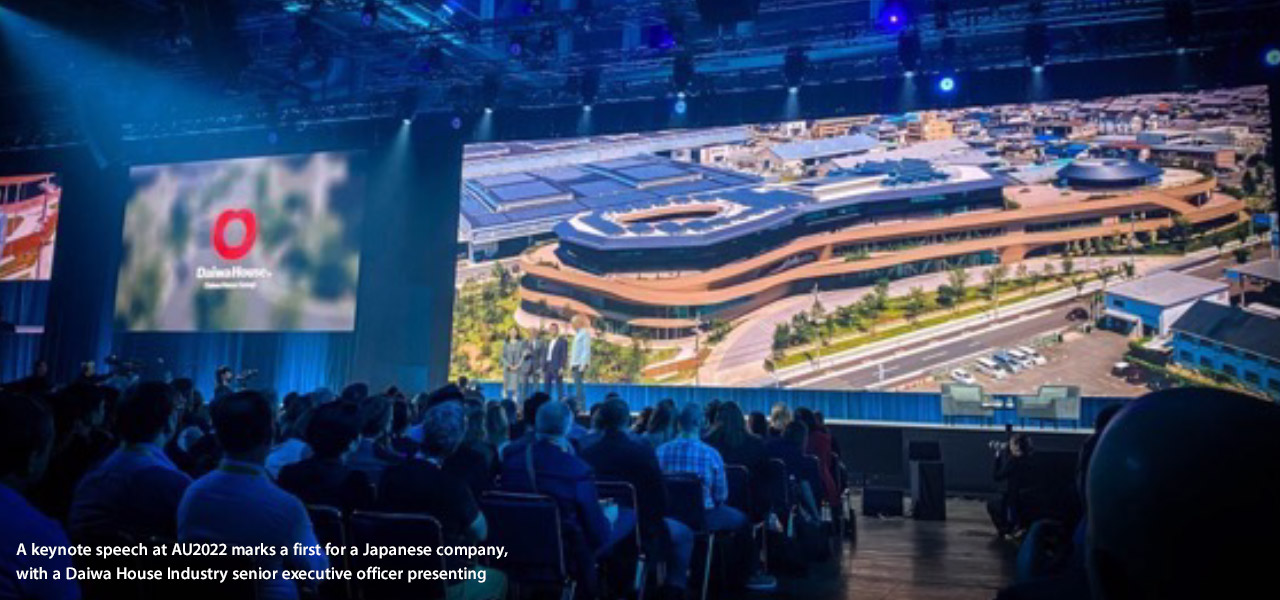
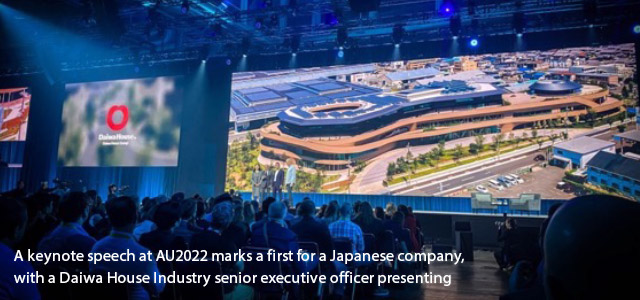

D’s BIM*, from America to the world
In September 2020, about a year after it had commenced activities as a leading driver of DX, Daiwa House Industry joined with Autodesk Inc., signing a memorandum of understanding to collaborate strategically with the aim of further accelerating BIM and DX. Again and again, the staff at Autodesk shattered the fixed expectations held by Terusaki and his colleagues. They raised questions like, “Those things you thought were impossible—why are they impossible?”
For instance, we would obtain information for conventional designs with questions via e-mail, phone, or even by meeting in person, then put it down by hand in the drawings. Then Autodesk would question us, asking, “Are you accumulating this as evidence? Will you be able to analyze this at a later date?” Of course not. We had felt the need for these things, but never came up with the idea of pursuing ways to find solutions.
However, leaving it as “impossible” prohibits progress. To start moving things forward we began to employ software from Autodesk. Having written down text of questions and response deadlines in a PDF, all questions were tagged and categorized, such as with “factors that led to that question.” In this way, although it will take more time than the conventional method, which required a mere 30 seconds per phone call, the burden will be reduced dramatically in a few years, as the causes that are overwhelming construction operations can be found, accumulated, and analyzed.
When collaboration with Autodesk was taking off, the annual global event “Autodesk University” (AU) held in the United States appeared on the radar. Innovators and companies from around the world who are at the forefront of architecture, manufacturing, media & entertainment, and other industries gather there to showcase and learn from each other’s cutting-edge technologies and initiatives. More than 450 sessions are held during the conference, while in 2022, approximately 10,000 people visited the venue and roughly 30,000 watched online.
Having learned of the event, Terusaki raised his hand, saying “I want to participate as a speaker.” Being a large-scale global event, time would be required to prepare to give a presentation in English, but in order to spread the D’s BIM initiative within the company, we felt it would be necessary to gain external recognition, not only in Japan but also overseas. From among proposals submitted from around the world, our proposal passed the third-party review and in September 2022 we went to New Orleans in the US. While many of the speakers were from management and head office departments, Terusaki and his team tackled this challenge like they were at a construction site, dressed in helmets and work uniforms. The session, in which people in the field reported on the real need for on-site DX, had a huge impact on the participants, as evidenced by the multitude of questions and exchanges of ideas.
Terusaki and his colleagues returned to Japan elated at the presentation’s success. Unfortunately, however, the results of their efforts attracted little attention within the company. This was not surprising since innovations in digital technology such as BIM are promoted primarily in design operations, and the digital revolution in construction still has a low profile. Field employees have their hands full dealing with the countless work tasks and do not have the spare capacity to catch up on new information. Indeed, given that Terusaki himself was unaware of his company’s participation in past AUs, he says that “The low level of response within the company is to be expected.”
Expressing his wish to stay active with this initiative, Terusaki added, “I’m convinced that the day is coming when DX will be further adopted in construction. When that happens, the fact that our company was quick off the mark to earn recognition at a global event will without doubt give us confidence.”
*D’s BIM: A project that aims to streamline business operations by using BIM in all the properties that Daiwa House Industry engages in.
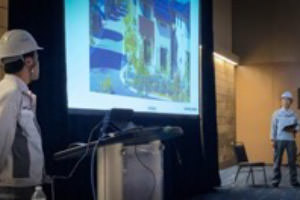
Terusaki and his team at the session
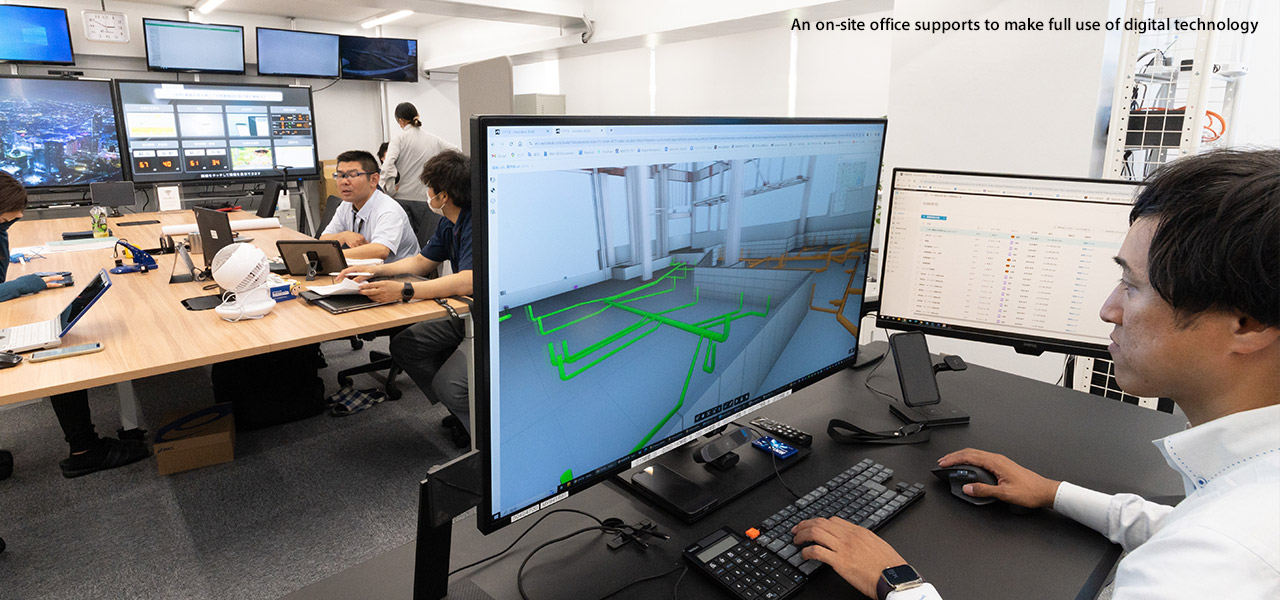


Creating a position
that offers a new way to work
In the days when remote work became commonplace on account of COVID-19, Terusaki welcomed a new employee to his team. Soon to be married, her partner was working and living in Gunma Prefecture. “Actually, I really want to stay on at the Tokyo Construction Division,” she said, voicing her concern. “Working on the construction of a major building has been my dream since college.”
After he had started working with her, Terusaki realized that this employee was truly exceptional. She excelled in what’s known as “field engineering,” which is the work done in the office, including communicating with clients and contractors, preparing resumes for regular meetings, and keeping track of construction drawings.
That’s when Terusaki had a lightbulb moment! If she could get into the flow of construction DX, she could contribute her abilities via remote work. While there had not yet been a case of remote work in the Construction Division, even though it was taking hold across the company, Terusaki promised her that he would pursue this possibility, saying, “Even if you live in Gunma, you should still be able to perform as a member of the Tokyo Construction Division. Let’s build that framework together.”
As a result of repeated negotiations with the Construction Division and HR, we had a model case for a new way of working where the employee would officially perform field engineering work remotely from Gunma. Some time later, when the employee went into maternity leave, she told us, “I thought that moving to Gunma would mean quitting my job, but I appreciate it so much that you were able to create an environment where I could think ‘I want to work here long term,’ and ‘I want to return here after maternity leave.’”
Moreover, the Production Engineering Group was established in the Tokyo Construction Division, something Terusaki had for years tirelessly promoted as necessary. The Front-loading Team is in charge of checking drawings for inconsistencies prior to the start of construction and feed-forwarding the work to the designers and facilities personnel. The Construction Drawing Team is responsible for drafting construction drawings for the site from before and even after the start of construction. The Production Engineering Group, like with field engineering, can also perform remotely, which opens up even more possibilities. You should not take it for granted that the workload of one person responsible for a particular task will increase, but that the burden will be distributed. Also, while seizing upon individual abilities, productivity will be increased. A place that fulfills such ideals has begun to gradually take shape.
Likely there are people at our business sites across the country who are concerned about a variety of conditions. Transforming institutions and organizations is not a simple matter, but without doubt, change has begun. Terusaki also says that since the flextime system was introduced, he is now able to drop his child off at daycare from time to time. Seeing other fathers pickup and drop off their kids, he had thought, “Why can’t we do that too?” That was the question that came to mind, but now that topic is in the past. The world is changing and the momentum of DX is unstoppable. We are confident that this new way of working will surely spread throughout the country.
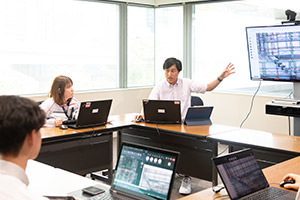
The newly formed Production Engineering Group
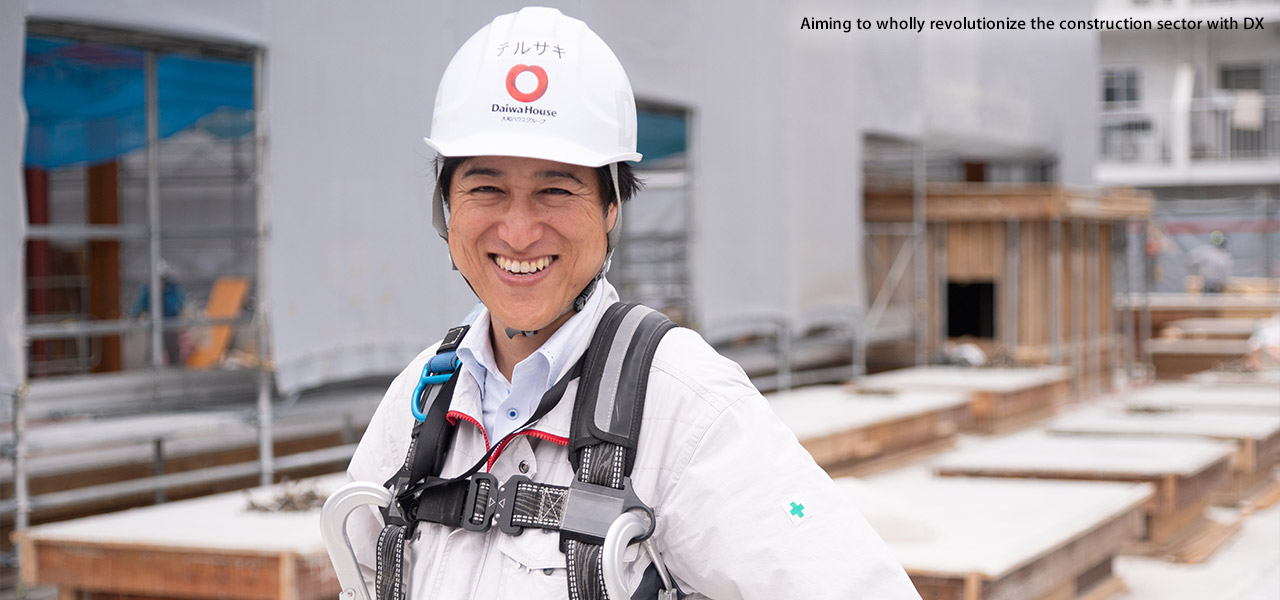
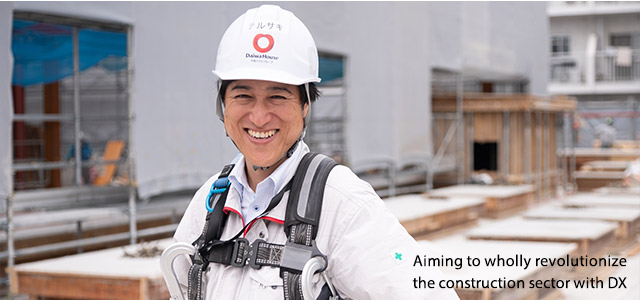

DX, certain to make our lives easier
Terusaki felt that “I couldn’t have imagined a construction site not utilizing DX, whether it be at the company level or for an individual personally. Not leveraging it is just plain risky.” This thought was triggered by a story he heard from the president of the U.S.-based Group company Daiwa House Construction Management Inc.
In America, a society based on contracts, construction industry contracts are extremely transparent. If a customer needs to amend something due to their own reasons, and if the request to do so is outside the scope of the contract, for certain construction will be suspended until a solution can be found. In Japan, general contractors are required to be flexible, although the construction period and the money paid often remain the same. It was a real eye-opener for Terusaki when that president told him, “I want to spread American culture to Japan. If things continue as they are, the construction industry in Japan will never improve.”
That was not the only reason for his sense of urgency. With growing impatience, he commented that “Japanese construction must move forward with DX in order to compete with overseas construction companies.” In other industries, the concern is already a reality. Moreover, DX literacy is a key to survival, not just for a company, but at the individual level as well. Terusaki asserts that there is an overwhelming difference in productivity that arises between those who can comprehend and utilize DX, and those who cannot.
Underlying Terusaki’s motivation for DX is his strong desire to make life easier for those involved in the construction process. “If construction is completed without incident there is a 100-point score.” Although he told of his concerns, “I worry about the high probability that the schedule will be delayed for reasons beyond anyone’s control, such as weather, or that an accident will occur and points will be deducted. So we desperately try to do our jobs and focus on getting to 100 points.” He continued to voice his worries, saying, “I walk around town on my days off, and I see the construction sites of other companies where everyone is sweating as they work, no matter what time of day or night, even on weekends. Will construction continue to be considered an attractive career under these circumstances?”
As DX at construction sites gains traction, changes will come to not only Daiwa House Industry but the entire construction industry. If the people working in the field have more time, calm minds, and a broader perspective, they will surely come up with more ideas that will benefit everyone. If an array of challenges can be overcome, maybe we can realize a 120-point site. The possibilities in the construction industry are endless.
“I like construction, and I like construction management work. So I want to increase the number of people who think, ‘I feel pride in being someone in charge in construction’ or ‘I want to get into construction,’” Terusaki says of his dream. Construction DX can transform construction management, or even make having a job in construction, more attractive. The future Terusaki sees is wide open and full of bright possibilities.
*Stated information is as of July 2023.
-
 "A Free Hand to Design a New World of Luxury Houses"
"A Free Hand to Design a New World of Luxury Houses"
-
 "The next mission in construction business"
"The next mission in construction business"
-
 "An Athlete’s Flying Start to His Second Life"
"An Athlete’s Flying Start to His Second Life"
-
 "Tackling the Challenges of Carbon Neutrality"
"Tackling the Challenges of Carbon Neutrality"
-
 "Building Close Relationships with Our Customers"
"Building Close Relationships with Our Customers"
-
 "Transforming the Construction Sector with DX"
"Transforming the Construction Sector with DX"
-
 "Bringing Ever-More Joy to Travel in Japan"
"Bringing Ever-More Joy to Travel in Japan"
-
 "Regeneration" Arises from New Construction
"Regeneration" Arises from New Construction
-
 "An Enduring Spirit of Hospitality"
"An Enduring Spirit of Hospitality"
-
 "Collaborating with 16 creators invited from around the world"
"Collaborating with 16 creators invited from around the world"
-
 "Passing Down Hometown to Future Generations with Renewable Energy"
"Passing Down Hometown to Future Generations with Renewable Energy"
-
 "The twenty-first century will be wind, solar, and hydro"
"The twenty-first century will be wind, solar, and hydro"
-
 "Be a Pioneer in the Design Revolution"
"Be a Pioneer in the Design Revolution"
-
 "Building better places to live through partnership between the public and private sectors"
"Building better places to live through partnership between the public and private sectors"
-
 "Supporting the foundations of the nation"
"Supporting the foundations of the nation"
-
 "Continuing to work the rest of life"
"Continuing to work the rest of life"
-
 "Doing our best to support post-disaster reconstruction"
"Doing our best to support post-disaster reconstruction"
-
 "Defying common wisdom in housing construction"
"Defying common wisdom in housing construction"
-
 "Develop the American market!"
"Develop the American market!"
-
 "Exporting Japanese industrial parks"
"Exporting Japanese industrial parks"
-
 "Industrializing agriculture"
"Industrializing agriculture"

